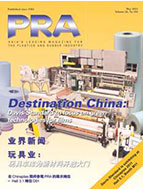 |
 |
E-News Update May 2011 |
LEAD FEATURE |
COMPANY NEWS |
MATERIALS NEWS |
MACHINERY NEWS |
EXHIBITION NEWS |
INJECTION MOULDING ASIA |
PRA May 2011 Electronic Issue Now Available |
Materials News
Self-healing polymers for the future
A
polymer-based material capable of repairing itself in less than a minute when exposed to ultraviolet light has been developed by a team of researchers at the Adolphe Merkle Institute of the University of Freiburg in Switzerland.The research team headed by Professor Chris Weder discovered the "self-healing" material, created through a process known as supramolecular assembly. Unlike conventional polymers, formed from long chains of molecules composed of hundreds of atoms, these supramolecular polymers are made up of smaller molecules that assemble into longer polymer chains, using metal ions as "molecular glue."
"The molecular design of these materials allows them to change their properties in response to high exposure to ultraviolet light," said Weder, a professor of chemistry and polymer materials and director of the Adolphe Merkle Institute.
In most cases, these new materials, which scientists have dubbed "metallo-supramolecular polymers", behave normally. But when irradiated with intense ultraviolet light, their structures "fall apart" temporarily. The solid material becomes liquid and flows easily. When the light is turned off, the material reassembles, and as it solidifies it recovers its original properties.
Using lamps such as those dentists use to cure fillings the researchers repaired scratches in their polymers. Wherever they waved the light beam, the scratches filled up and disappeared, much like a cut that heals and leaves no trace on skin.
Tests showed the researchers could repeatedly scratch and heal their materials in the same location.
Though the polymers are not ready for commercialisation, they could one day be used in automotive paints, varnishes for floors and furniture and other applications like mobile phone covers.
The research was funded by the US Army Research Office of the US Army Research Laboratory, the US National Science Foundation and the Adolphe Merkle Foundation.

